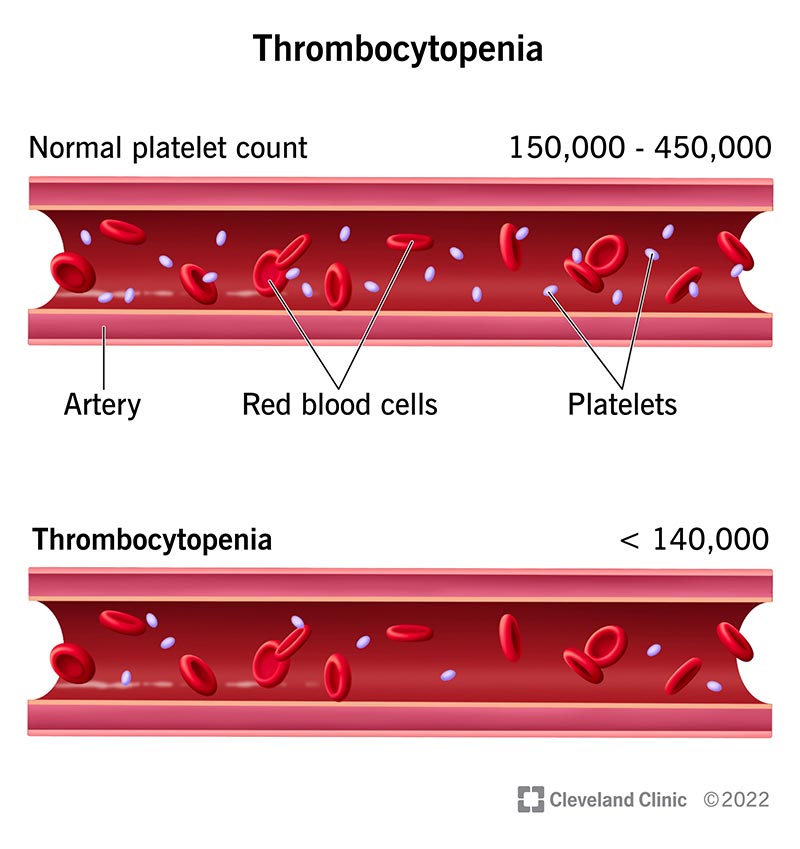Thrombocytopenia: Symptoms, Causes, Treatment
What are the symptoms of thrombocytopenia?
Thrombocytopenia is a condition characterized by a low platelet count in the blood. Platelets are important for blood clotting, so a low platelet count can lead to excessive bleeding or easy bruising. The symptoms of thrombocytopenia can vary depending on the underlying cause and the severity of the condition, but common symptoms may include:
- Excessive bruising: People with thrombocytopenia may bruise easily, and their bruises may be larger or more noticeable than usual.
- Petechiae: These are small, pinpoint-sized red or purple spots on the skin caused by bleeding under the skin. Petechiae are a common sign of thrombocytopenia.
- Purpura: Purpura are larger patches of purple or red skin discoloration caused by bleeding under the skin. They are similar to bruises but larger.
- Nosebleeds: Thrombocytopenia can cause frequent or prolonged nosebleeds.
- Bleeding gums: People with thrombocytopenia may experience bleeding gums, especially after brushing their teeth or flossing.
- Blood in the urine or stool: Thrombocytopenia can cause bleeding in the urinary tract or gastrointestinal tract, leading to blood in the urine or stool.
- Heavy menstrual periods: Women with thrombocytopenia may experience heavier than normal menstrual periods.
- Prolonged bleeding from cuts or injuries: People with thrombocytopenia may bleed for longer than usual after sustaining a cut or injury.
- Fatigue: In some cases, thrombocytopenia can lead to fatigue or weakness due to chronic bleeding.
It’s important to note that the symptoms of thrombocytopenia can vary widely among individuals, and not everyone with thrombocytopenia will experience all of these symptoms. If you are experiencing symptoms of thrombocytopenia, it’s important to consult with a healthcare professional for an accurate diagnosis and appropriate treatment.
What are the causes of thrombocytopenia?
Thrombocytopenia can be caused by a variety of factors that affect the production, destruction, or distribution of platelets in the body. Some common causes of thrombocytopenia include:
- Decreased production of platelets: Certain medical conditions, such as leukemia, myelodysplastic syndromes, and aplastic anemia, can decrease the production of platelets in the bone marrow, leading to thrombocytopenia.
- Increased destruction of platelets: Immune thrombocytopenic purpura (ITP) is a condition in which the immune system mistakenly attacks and destroys platelets, leading to a low platelet count. Other conditions that can cause increased destruction of platelets include thrombotic thrombocytopenic purpura (TTP), hemolytic uremic syndrome (HUS), and drug-induced immune thrombocytopenia.
- Medications: Some medications, such as certain antibiotics, anticonvulsants, and diuretics, can cause thrombocytopenia by affecting platelet production or function.
- Infections: Viral infections, such as hepatitis C, HIV, and cytomegalovirus (CMV), can lead to thrombocytopenia by affecting platelet production or increasing platelet destruction.
- Autoimmune disorders: Certain autoimmune disorders, such as systemic lupus erythematosus (SLE) and rheumatoid arthritis, can cause the immune system to attack platelets, leading to thrombocytopenia.
- Liver disease: Liver disease can affect the production of thrombopoietin, a hormone that stimulates platelet production, leading to thrombocytopenia.
- Alcohol abuse: Chronic alcohol abuse can affect the production of thrombopoietin and lead to thrombocytopenia.
- Certain cancers: Some cancers, such as lymphoma and multiple myeloma, can lead to thrombocytopenia by affecting platelet production or increasing platelet destruction.
- Pregnancy: Thrombocytopenia can occur during pregnancy due to increased platelet destruction or consumption.
- Genetic disorders: Rare genetic disorders, such as Wiskott-Aldrich syndrome and May-Hegglin anomaly, can cause thrombocytopenia due to abnormalities in platelet production or function.
It’s important to note that the causes of thrombocytopenia can vary widely among individuals, and in some cases, the cause may not be known. If you are experiencing symptoms of thrombocytopenia, it’s important to consult with a healthcare professional for an accurate diagnosis and appropriate treatment.
What is the treatment for thrombocytopenia?
The treatment for thrombocytopenia depends on the underlying cause and the severity of the condition. In some cases, no treatment may be necessary, especially if the low platelet count is mild and not causing symptoms. However, if treatment is needed, it may include:
- Medications:
- Corticosteroids: These can help reduce the activity of the immune system and may be used to treat immune thrombocytopenic purpura (ITP).
- Immunoglobulins: Intravenous immunoglobulin (IVIG) can help increase platelet counts in some cases of ITP.
- Thrombopoietin receptor agonists: These medications stimulate the production of platelets and may be used to treat ITP.
- Platelet transfusion: In cases of severe thrombocytopenia or active bleeding, a platelet transfusion may be necessary to increase the platelet count quickly.
- Splenectomy: If the spleen is causing the destruction of platelets, removing the spleen (splenectomy) may be recommended.
- Treatment of underlying conditions: If thrombocytopenia is caused by an underlying condition, such as a viral infection or cancer, treating the underlying condition may help improve platelet counts.
- Avoiding medications that can cause thrombocytopenia: If thrombocytopenia is caused by a medication, stopping or switching to a different medication may be necessary.
- Lifestyle changes: Making lifestyle changes, such as avoiding activities that increase the risk of bleeding and maintaining a healthy diet, can help manage thrombocytopenia.
It’s important to note that the treatment for thrombocytopenia should be individualized based on the underlying cause and the specific needs of the patient. It’s important for individuals with thrombocytopenia to work closely with a healthcare professional to develop a treatment plan that is tailored to their specific needs.




